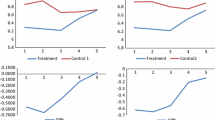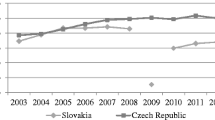Abstract
Even though there are many quasi-experimental research in recent literature, there is still no consensus on whether an increase in school funding improves student achievement. Leveraging a natural experiment in South Korea, this study exploits the discontinuity in school funding rules to identify the impact of increased funding on the test scores of high-school students in a national assessment exam. The setting provides a useful context to study the effect of school funding because students typically attend largely similar schools that follow a standardized curriculum, thus eliminating the possibility of the results being contaminated by idiosyncratic variation in school-level characteristics. This study reports mean regression discontinuity estimates as well as quantile regression discontinuity estimates using a procedure suggested by Frandsen et al. (J Econom 168:382–395, 2012). The findings reveal that an increase in school funding, which is equal to approximately 300,000 won per student, results in improved exam performance, particularly in mathematics. Contrary to the stated purpose of the program, however, the evidence suggests that students in the middle and top of the ability distribution gained the most from the intervention, rather than students who are at the highest risk of failing.








Similar content being viewed by others
Notes
A parallel literature has considered the effect of school quality more broadly, considering the effect of high versus low quality education regimes. The most notable study in this literature is that of Card and Krueger (1992) who use earnings data from the U.S. Census and the state in which an individual received the majority of his education to assess the effect of educational quality on subsequent earnings.
South Korea’s education system is as follows: elementary school (6 years), middle school (3 years), and high school (3 years).
Note that the grade numbers start over again at each school level in South Korea, which is different from the US.
The class size variable that we used in our analysis indicates the number of students in a homeroom class. In South Korea, every student is assigned a homeroom class within a school, and the class size variable denotes the average number of students in a homeroom class. The pupil-to-teacher ratio variable is obtained by dividing the total number of students (in grade 10 to 12) in a school by the total number of teachers in a school.
For the quantile regression discontinuity estimator, we benefited from the STATA code provided by the authors.
We also implement the formal test suggested by McCrary (2008) which compares the height of the bars of a histogram local to the discontinuity. We fail to reject that the frequency is smooth across the threshold.
References
Bogart, W. T., & Cromwell, B. A. (1997). How much more is a good school district worth. National Tax Journal, 50(2), 215–232.
Card, D., & Krueger, A. B. (1992). Does school quality matter? Returns to education and the characteristics of public schools in the United States. Journal of Political Economy, 100(1), 1–40.
Card, D., & Payne, A. A. (2002). School finance reform, the distribution of school spending, and the distribution of student test scores. Journal of Public Economics, 83, 49–82.
Chay, K. Y., McEwan, P. J., & Urquiola, M. (2005). The central role of noise in evaluating interventions that use test scores to rank schools. American Economic Review, 95(4), 1237–1258.
Clapp, J. M., Nanda, A., & Ross, S. L. (2008). Which School attributes matter? The influence of school district performance and demographic composition on property values. Journal of Urban Economics, 63, 451–466.
Downes, T. A., & Zabel, J. (2002). The impact of school characteristics on house prices: Chicago 1987–1991. Journal of Urban Economics, 52, 1–25.
Fan, J., & Gijbels, I. (1996). Local polynomial modelling and its applications. New York: Chapman and Hall.
Frandsen, B. R., Frölich, M., & Melly, B. (2012). Quantile treatment effects in the regression discontinuity design. Journal of Econometrics, 168, 382–395.
Goodman, A. C., & Thibodeau, T. G. (1998). Dwelling age heteroskedasticity in repeat sales house price equations. Real Estate Economics, 26(1), 151–171.
Guryan, J. (2001). Does money matter? Regression-discontinuity estimates from education finance reform in Massachusetts. NBER working paper No. w8269, National Bureau of Economic Research.
Häkkinen, I., Kirjavainen, T., & Uusitalo, R. (2003). School resources and student achievement revisited: New evidence from panel data. Economics of Education Review, 22, 329–335.
Hanushek, E. A. (1986). The economics of schooling: Production and efficiency in public schools. Journal of Economic Literature, 24(3), 1141–1177.
Hanushek, E. A. (1994). A jaundiced view of adequacy in school finance reform. Educational Policy, 8(4), 460–469.
Hanushek, E. A. (1997). Assessing the effects of school resources on student performance: An update. Educational Evaluation and Policy Analysis, 19(2), 141–164.
Hedges, L. V., Laine, R. D., & Greenwald, R. (1994). Does money matter? A meta-analysis of studies of the effects of differential school inputs on student outcomes. Educational Researcher, 23(3), 5–14.
Jacob, B. A., & Lefgren, L. (2004). Remedial education and student achievement: A regression-discontinuity analysis. Review of Economics and Statistics, 86(1), 226–244.
Lazear, E. P. (2006). Speeding, terrorism, and teaching to the test. Quarterly Journal of Economics, 121(3), 1029–1061.
McCrary, J. (2008). Manipulation of the running variable in the regression discontinuity design: A density test. Journal of Econometrics, 142, 698–714.
Papke, L. E. (2005). The effects of spending on test pass rates: Evidence from Michigan. Journal of Public Economics, 89, 821–839.
van der Klaauw, W. (2008). Breaking the link between poverty and low student achievement: An evaluation of title 1. Journal of Econometrics, 145, 21–42.
Verstegen, D. A., & King, R. A. (1998). The relationship between school spending and student achievement: A review and analysis of 35 years of production function research. Journal of Education Finance, 24(2), 243–262.
Author information
Authors and Affiliations
Corresponding author
Additional information
Publisher's Note
Springer Nature remains neutral with regard to jurisdictional claims in published maps and institutional affiliations.
Rights and permissions
About this article
Cite this article
Han, D., Kim, S., Park, H. et al. Promoting student achievement in high school using school funding: evidence from quantile regression discontinuity design. Asia Pacific Educ. Rev. 22, 193–208 (2021). https://doi.org/10.1007/s12564-020-09667-5
Received:
Revised:
Accepted:
Published:
Issue Date:
DOI: https://doi.org/10.1007/s12564-020-09667-5




